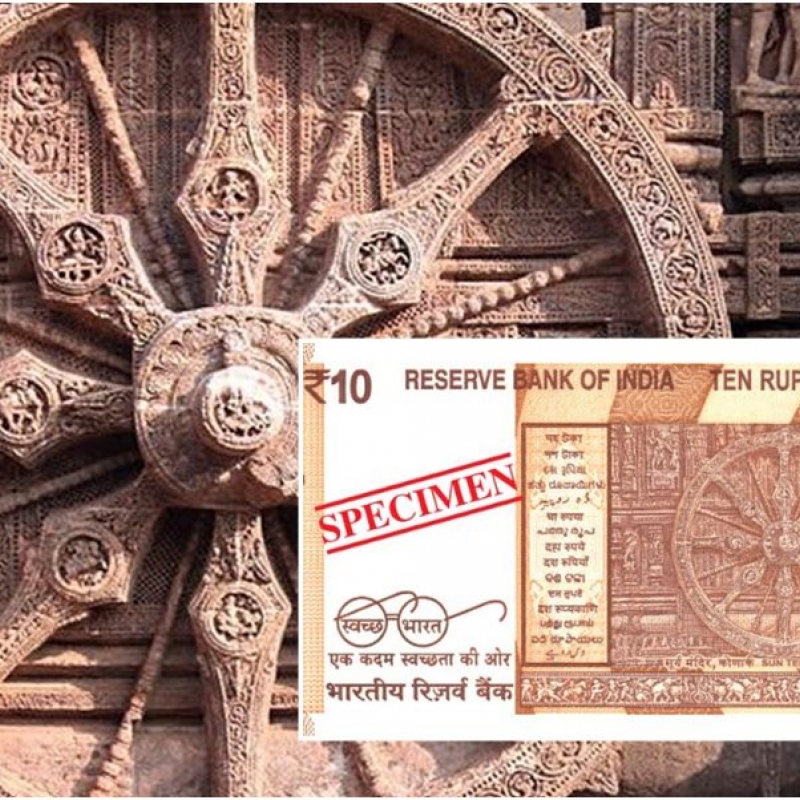Hot on the heels of the RBI introducing the new Rs 100 banknote showcasing the stunningly ornate Rani ki Vav, and ahead of World Tourism Day, Sahapedia looks at the monuments that are currently featured in the latest series of notes issued by the central bank, should they inspire the traveller in you as well
After the demonetisation of the Rs 500 and Rs 1000 currency notes on November 8, 2016, we've seen five new currency notes from the Reserve Bank of India (RBI). Fresh off the mint is the Rs 100 note, which was unveiled on July 19, 2018. While not many of us might spend time staring at currency notes or even ponder over the design—other than those aspects that help verify its authenticity—there is, in fact, a great deal of thought put into its designing. As RBI says on its website, 'Currency notes reflect the nation’s rich and diverse culture, her struggle for freedom and her proud achievements as a nation.'
In the latest series, labelled the 'Mahatma Gandhi new series' by RBI, five of the six banknotes interestingly feature prominent historical Indian monuments on the reverse side, which suggests a focus on India's heritage and culture. As graphic designer Itu Chaudhuri once told an English-language daily, 'All banknotes are an exercise in national image building.' While the Ashoka Pillar was the first sculptural emblem to be featured on a banknote issued in Independent India, some of the other prominent structures to grace the legal tender have been the Brihadeshwara (Brihadisvara) Temple in Tanjore on the Rs 1000 note and the Gateway of India in Mumbai on the Rs 5000 note—both issued in 1954.
In the 1980s, there was a shift in the design motifs to showcase 'symbols of Science and Technology (Aryabhatta on the Rs 2 note), Progress (the Oil Rig on Re 1 and Farm Mechanisation on Rs 5) and a change in orientation to Indian art forms on the Rs 20 and the Rs 10 notes.' Again in 1996, a new set of banknotes (Rs 10, Rs 50, Rs 100, Rs 500 and Rs 1000) were issued—the Mahatma Gandhi series, mostly with very artistic designs. Only the Rs 50 note featured a building, which was the Indian Parliament House, on the reverse.
Then came the fateful November 8, 2016, a date that changed the fates of both India and the US. Since then, the currency market has been fairly volatile. While we won’t go into the intricacies of foreign exchange and the fluctuations in the US, closer home, the changes have been quite tangible with the introduction of a new series of banknotes by the RBI.
The first new notes in this series were available starting November 9, 2016, which were Rs 2000 and Rs 500. The magenta Rs 2000 note featured the much-acclaimed Mangalyaan on the reverse side, while the stone-grey Rs 500 shows the ramparts of the Red Fort in New Delhi. With the unveiling of the latest Rs 100 note, we now have five banknotes in circulation that showcase some of India’s stunning monuments on the reverse side.
Here's a look at the monuments that are currently featured on the contemporary Indian banknotes, and some interesting factoids about them.
Rs 10 - Konark Sun Temple, Odisha
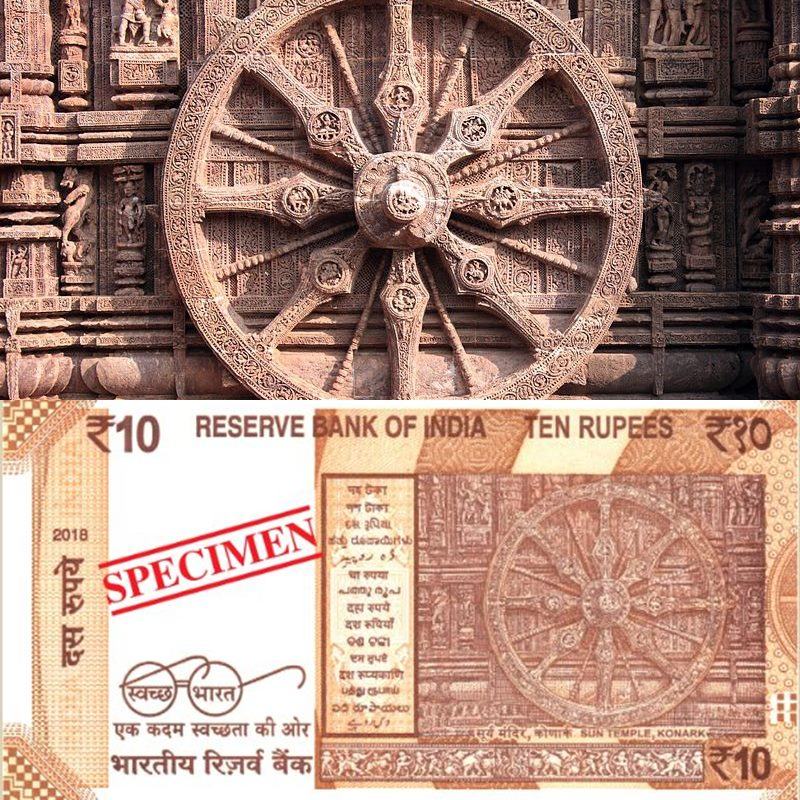
The Rs 10 currency note features the famous Konark wheel from the temple in Odisha (Photo source - top: Mohammed A/Wikimedia Commons)
The Rs 10 banknote was announced by RBI on January 5, 2018. While the front side has the profile portrait of Mahatma Gandhi, this paper note has the intricately carved Konark Sun Temple from Odisha on the reverse. This 13th-century sun temple forms part of the golden triangle of Odisha (along with Puri and Bhubaneswar) for travellers and pilgrims. Conceived and built by King Narasimhadeva I as Surya's chariot, this was one of the tallest and grandest temples in India at the time. A fair bit has been written about the building's erotic imagery, though its uniqueness lies in the depiction of time through architecture, wherein the chariot is pulled by Surya's seven horses (symbolic of the seven days of the week, or the seven metres of Sanskrit prosody). The chariot's 12 pairs of wheels symbolise the 12 months of the Hindu calendar, the 24 wheels stand for the number of hours in a day, and the eight major spokes in each wheel signify the division of the day into prahars. No wonder then that this mathematical marvel was recognised as a World Heritage Site by UNESCO in 1984.
Rs 50 - Stone Chariot of Hampi, Karnataka
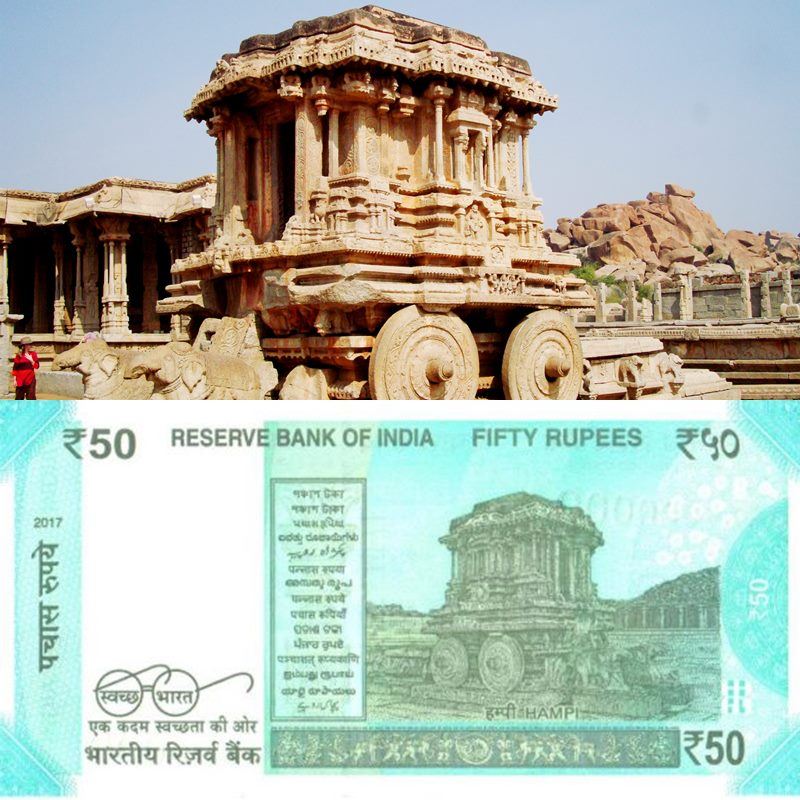
The Rs 50 currency note features the stone chariot in Hampi (Photo source - top: Anusha ss india/Wikimedia Commons)
The fluorescent blue banknote worth Rs 50 was officially announced on August 18, 2017, and features yet another chariot temple, but this time from Hampi in Karnataka. Images of the Garuda Stone Chariot have often been used as a symbol of Hampi's treasure trove of temples, which were collectively listed as a UNESCO World Heritage Site in 1986. This intricately carved chariot is actually a Garuda shrine in the Vitthala (a form of Krishna) temple complex, and has two elephants towards the front, positioned in a manner as if they are pulling it. According to Hindu mythology, Garuda is said to be Vishnu's vahana (vehicle), and apparently a huge sculpture once sat on the chariot, which currently lies empty. With around 1,600 surviving structures inspired by the Dravidian style of architecture, the Hampi group of monuments was built between the 14th and 16th centuries during the Vijayanagara Empire. It's said that this chariot was commissioned by King Krishnadevaraya in the 16th century, and modelled on Konark's sun temple after he had fought a battle in the region. Called an 'austere and grandiose site' by UNESCO, the 'exquisitely ornate' work on the Vitthala temple and the stone chariot have often been hailed as representative of 'the culmination of Vijayanagara temple architecture'. (Click here to take a virtual tour of the Vittala Temple complex.)
Rs 100 - Rani ki Vav, Gujarat
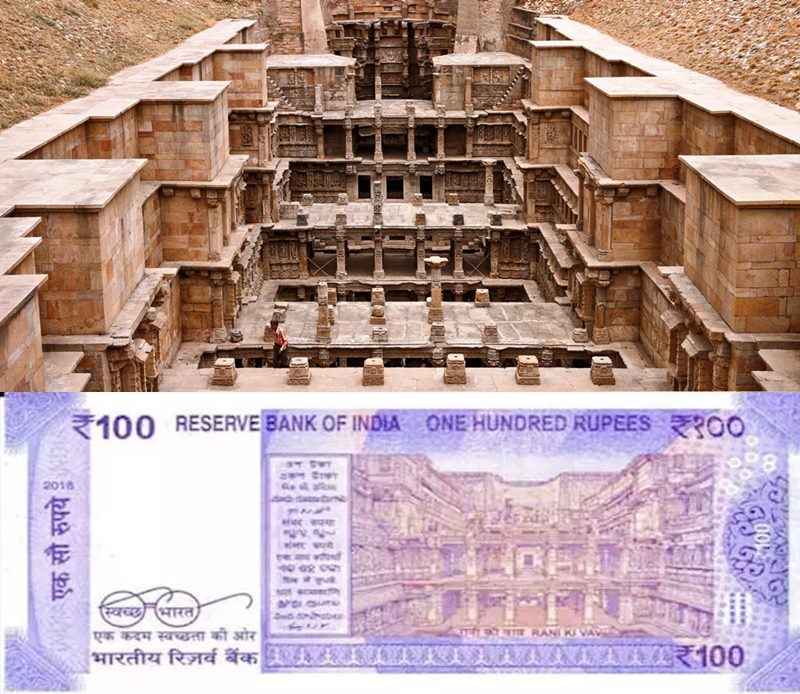
The Rs 100 currency note features the 11th century stepwell Rani ki Vav in Gujarat (Photo source - top: Kirit Mankodi/Sahapedia)
On July 19, 2018, the Reserve Bank of India unveiled the revised design of the Rs 100 banknote, which features the stunningly ornate 11th century stepwell—Rani ki Vav, located in Patan, Gujarat. Built by the Solanki Queen Udayamati as a memorial to her husband, King Bhimadeva I, the stepwell is extremely well-preserved. It is about 65 metres long from the entrance to the well, about 20 metres broad and more than 30 metres deep. A Vaishnava site (which was common at the time since in mythology Lord Vishnu is intimately associated with cosmic waters), the stepwell also has a number of Parvati or Gauri sculptures, which are meant to represent the Queen as a widow, who builds the stepwell as a means of penance; appeasing the gods so that she can be with her husband in another realm. There are 700–800 sculptures of deities and mythological figures. Since the site had been flooded for around 800 years, these sculptures and ornate pillars have been exceptionally well-preserved. Rani ki Vav was declared a UNESCO World Heritage Site in 2014. (Click here to know more about Rani ki Vav.)
Rs 200 - Sanchi Stupa, Madhya Pradesh

The Rs 200 currency note features the famous Buddhist site of Sanchi in Bihar (Photo source - top: Sahapedia)
The very orange Rs 200 currency note debuted on August 24, 2017, and it prominently features the 2nd-1st century BCE Buddhist monument Sanchi Stupa with one of its ornate gateways on the reverse side. Built by Emperor Ashoka, it is said to be the oldest Buddhist sanctuary in existence and was a major Buddhist centre in India till about the 12th century. In fact, over the centuries, there have been additional structures built over the original hemispherical dome (which covered Buddha's relics). The site's signature elements are the four beautifully carved toranas (gateways), one of which is also featured prominently in the currency note. The carvings on these gateways show tales from Buddha's life as well as his early incarnations, which are commonly known as Jataka Tales.
The Sanchi monuments, along with the main stupa, were declared a World Heritage Site by UNESCO in 1989. (Click here for more images of the Sanchi Stupa Complex.)
Rs 500 - Red Fort, Delhi
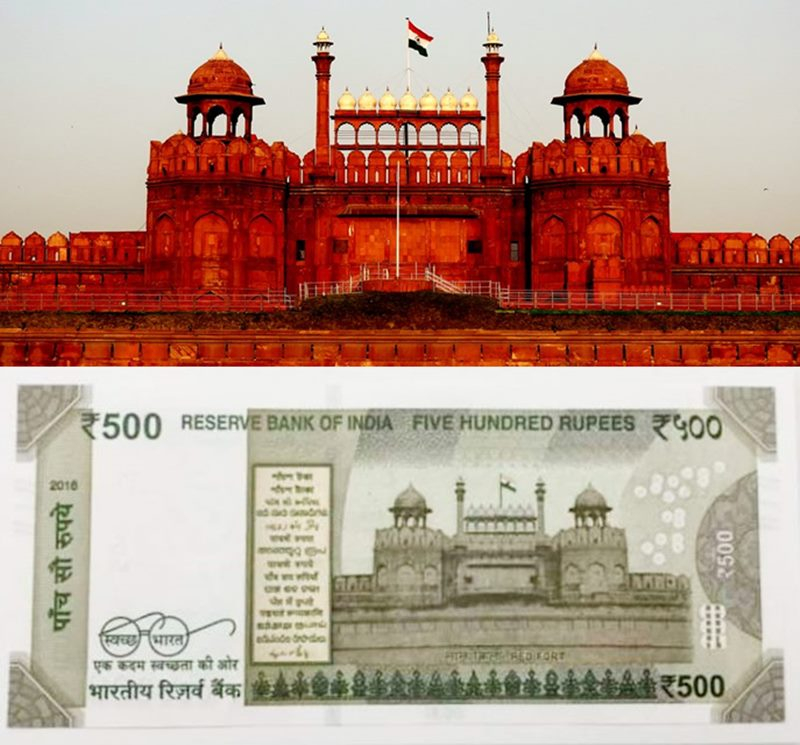
The Rs 500 currency note features the ramparts of the Red Fort in Delhi (Photo source - top: Wikimedia Commons)
The new Rs 500 note was issued within hours of November 8, 2016's fateful announcement by the Indian Prime Minister, along with the new magenta Rs 2000 banknote. It features the very familiar ramparts of the Red Fort in Delhi, along with the national flag flying high. One of the main residences of the Mughal Dynasty for almost 200 years, the city fort made of red sandstone was built in the 17th century, but not many know that it was originally called Qila-i-Mubarak, or the 'Blessed Fort'. Also a UNESCO World Heritage Site, the Red Fort is unlike all the other monuments featured on this list as it continues to serve a modern-day purpose as the annual platform for the Prime Minister to deliver his address to the nation on Independence Day.
